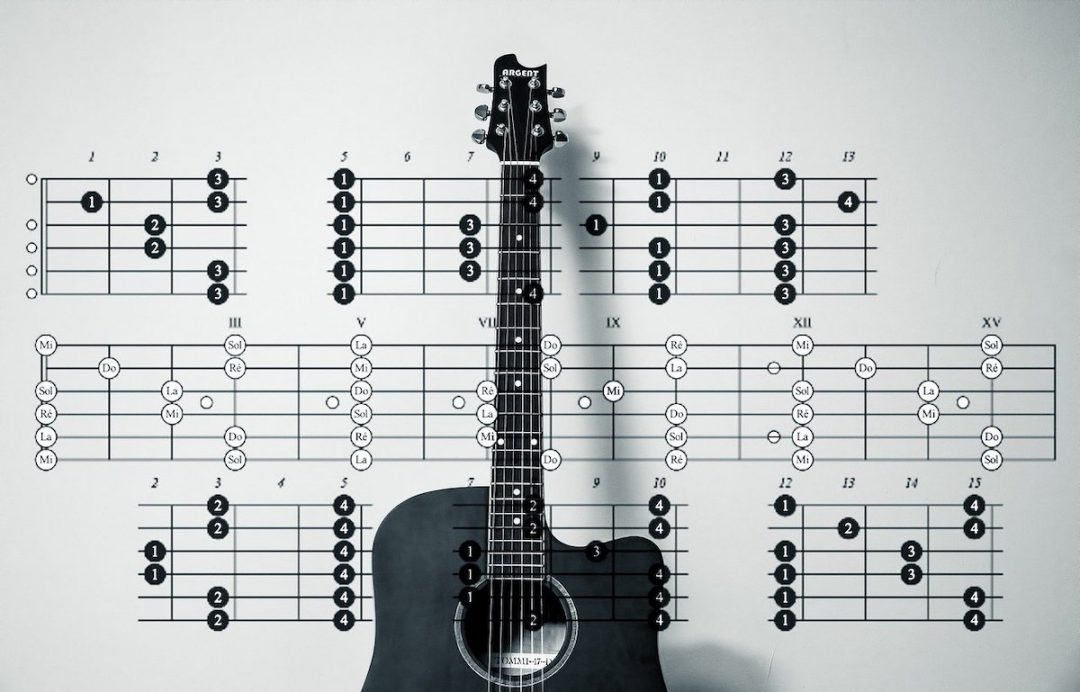Diminished chords are native to both major and minor keys. You’ll find them as the seventh chord of the major scale, and the second chord of the natural minor scale. They get a bad rap for being dissonant, but they can add a lot of spice to an otherwise bland chord progression!
What is a diminished chord?
A diminished chord is a triad (3-note chord) built from the root note, a minor third, and a flat (a.k.a., diminished) fifth. They have two minor thirds above the root — from root to minor third is one, and from minor third to flat fifth is two.
The easiest way to think of them is having a flat third as well as a flat fifth. Let’s compare a C major triad to a C diminished triad, for example:
- C Major: C – E – G
- C diminished: C – Eb – Gb
As you can see, both the third (E) and the fifth (G) are flat in C diminished.
These somewhat unusual chords create drama and tension — they’re dissonant, which is one of the easiest ways to inject tension into a chord progression. Their overall timbre can even be described as evil. Great for metal!
The flat fifth is the perfect component for creating instability in a progression, and thus a desire for resolving to the key’s tonic. This is a great songwriting trick; lead listeners away from the tonic with a diminished chord, then return to it for a big, impactful resolution.
How do you make them?
Diminished chords are straightforward to make because the notes are each spaced by a third. This means there are 3 half-steps between each note in the chord.
And then there are actually three main kinds of diminished chords: diminished triads, diminished sevenths, and half-diminished sevenths. Using the tonic of D as an example, we can explore how to create each of these different chords.
Diminished Triad
- Root
- Minor third
- Diminished fifth
It’s good to know the chord symbols if you ever seen them in notation. For a standard diminished triad, they’re represented by ‘dim’ and ‘°.’ On paper you’d see them written like Ddim or D°.
To put one of these together, first find the root note of the chord. This will always be the foundation from which we build up. We’re using D as our example, so that should be the note we start with. Now count three half-steps up from D to find the next note:
- D – D# (1) – E (2) – F (3)
A minor third above D is F.
To find the last note in Ddim, count another three half-steps up from F:
- F – F# (1) – G (2) – Ab (3)
Ab is a minor third above F; it’s also a diminished fifth above D. So, all of the notes in a Ddim chord are D – F – Ab.
Diminished Seventh
- Root
- Minor third
- Diminished fifth
- Diminished seventh
In notation, you’ll see diminished seventh chords written as dim7 or °7. As you can see, we’ve added an additional note to the chord.
The diminished seventh, also known as a fully diminished chord, adds an additional minor third above the fifth. This means that the seventh note is three half-steps above the flat fifth.
We know that Ab is our diminished fifth in the key of D. Let’s count three half-steps up from Ab to find the diminished seventh:
- Ab – A (1) – Bb (2) – B/Cb (3)
So, the seventh note in a Ddim7 chord is Cb. The Ddim7 chord has the notes D – F – Ab – Cb.
Half-Diminished Seventh
Also called a m7b5 (minor 7, flat 5) the half-diminished seventh is another four-note chord. You’ll see it notated as Dm7b5 or Dø7.
- Root
- Minor third
- Diminished fifth
- Minor seventh
The difference between a diminished seventh and a half-diminished seventh is the final note in the chord. Instead of being a diminished seventh, we have a minor seventh — one half-step higher than a diminished seventh. So, the seventh note is four half-steps above the flat fifth instead of 3:
- Ab – A (1) – Bb (2) – Cb (3) – C (4)
The Dø7 chord has the notes D – F – Ab – C. C is an additional half-step higher than Cb, and creates a minor seventh interval above the root note D rather than a diminished seventh interval.
Diminished Chord Chart
Diminished chords exist in all 12 keys. We mentioned earlier that the diminished triad is the seventh scale degree of the major scale, and the second scale degree of the minor scale.
Here are the notes of all 12 diminished triads:
- C dim = C – Eb – Gb
- C# dim = C# – E – G
- Db dim = Db – E – G
- D dim = D – F – Ab
- Eb dim = Eb – Gb – A
- E dim = E – G – Bb
- F dim = F – Ab – B
- F# dim = F# – A – C
- Gb dim = Gb – A – C
- G dim = G – Bb – Db
- Ab dim = Ab – B – D
- A dim = A – C – Eb
- Bb dim = Bb – Db – E
- B dim = B – D – F
Conclusion
Diminished chords are dissonant weirdos! They’re great for creating suspense and tension within a chord progression, or to simply make a song more interesting.
- Related: Circle of Fifths – Easily Navigate Every Key
- Related: 8 Best Bass Guitar VSTs
- Related: Boss Katana Air Wireless Guitar Amplifier Review
